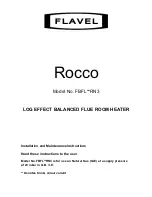
E
ng
lish
5
Figure 2
MINIMUM CLEARANCE: From normal combustible material
Clearance
DXH125FAV DXH150FAV
From floor ..................................0 ft.........................0 ft.
From outlet ................................8 ft.........................8 ft.
From sides ................................3 ft.........................3 ft.
From top ....................................6 ft.........................6 ft.
Locate 10 ft. from canvas or plastic tarpaulins or similar coverings
and secure them to prevent flapping or movement due to wind
action.
Figure 1
VENTILATION: Minimum openings required
Opening Opening
Heater
near floor near ceiling
Forced air (DXH125FAV, DXH150FAV)...........2 ft
2
....... ...........2 ft
2
Fuel Gas Odor—Fuel Leaks
LP gas and natural gas have man-made odorants added specifically
for detection of fuel gas leaks. If a gas leak occurs you should be able
to smell the fuel gas. Since Propane (LP) is heavier than air you should
smell for the gas odor low to the floor. ANY GAS ODOR IS YOUR SIGNAL
TO TAKE IMMEDIATE ACTION!
WARNING
WARNING: RISK OF ASPHYXIATION
•
Do not use in unventilated areas.
•
The flow of combustion and ventilation air must not be obstructed.
•
Proper ventilation air must be provided to support the combustion air
requirements of the heater being used.
•
Refer to the specification section of the heater’s manual, heater dataplate,
or contact the factory to determine combustion air ventilation
requirements of the heater.
•
Lack of proper ventilation air will lead to improper combustion.
•
Improper combustion can lead to carbon monoxide poisoning leading to
serious injury or death. Symptom of carbon monoxide poisoning
can include headaches, dizziness and difficulty in breathing.
•
Do not take any action that could ignite the fuel gas. Do not operate any
electrical switches. Do not plug in or disconnect any power supply or
extension cords. Do not light matches or any other source of flame. Do
not use your telephone.
•
Get everyone out of the building and away from the area immediately.
•
Close all propane (LP) gas tank or cylinder fuel supply valves, or the main
fuel supply valve located at the meter if you use natural gas.
•
Propane (LP) gas is heavier than air and may settle in low areas. When
you have reason to suspect a propane leak, keep out of all low areas.
•
Use your neighbor’s phone and call your fuel gas supplier and your fire
department. Do not re-enter the building or area.
•
Stay out of the building and away from the area until declared safe by the
firefighters and your fuel gas supplier.
•
FINALLY, let the fuel gas service person and the firefighters check for
escaped gas. Have them air out the building and area before you return.
Properly trained service people must repair any leaks, check for further
leakages, and then relight the appliance for you.
Odor Fade Warning
Odor Fading—No Odor Detected
•
Some people cannot smell the odor of the man-made chemical added
to propane (LP) or natural gas. You must determine if you can smell the
odorant in these fuel gases.
•
Learn to recognize the odor of propane (LP) gas and natural gas. Local
propane (LP) gas dealers will be more than happy to give you a scratch and
sniff pamphlet. Use it to become familiar with the fuel gas odor.
•
Smoking can decrease your ability to smell. Being around an odor for a
period of time can affect your sensitivity to that particular odor. Odors
present in animal confinement buildings can mask fuel gas odor.
Summary of Contents for DXH125FAV
Page 10: ...English 10 DXH125FAV ...
Page 12: ...12 English DXH150FAV ...
Page 14: ......
Page 24: ...Français 10 DXH125FAV ...
Page 26: ...12 Français DXH150FAV ...
Page 37: ...Español 10 DXH125FAV ...
Page 39: ...12 Español DXH150FAV ...






































